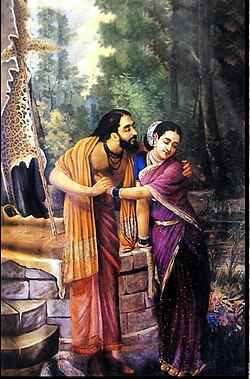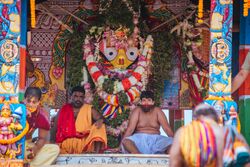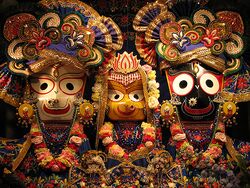Subhadra
Topic: Religion
 From HandWiki - Reading time: 8 min
From HandWiki - Reading time: 8 min
| Subhadra | |
|---|---|
 A painting by Raja Ravi Varma depicting Arjuna, dressed as an ascetic, courting Subhadra | |
| Other names | Bhadra, Chitra |
| Affiliation | Devi |
| Texts | Mahabharata, Bhagavata Purana |
| Personal information | |
| Parents |
|
| Siblings |
|
| Consort | Arjuna |
| Children | Abhimanyu (son) |
| Dynasty | Yaduvamsha – Chandravamsha |
Subhadra (Sanskrit: सुभद्रा, romanized: Subhadrā) is a figure in Hindu mythology, known for being the younger sister of gods Krishna and Balarama. According to Hindu scriptures, she was a princess from the Yadava clan, who married Arjuna—one of the Pandava brothers—and had a son named Abhimanyu.
Subhadra is part of the triad of deities worshipped at the Jagannath Temple at Puri, along with Krishna (as Jagannatha) and Balarama (or Balabhadra). One of the chariots in the annual Ratha Yatra is dedicated to her.
Etymology and other names
The Sanskrit name Subhadrā is made up of two words: su and bhadrā. The prefix su denotes goodness,[1] while bhadrā is translated as fortune or excellence.[2] The name means 'glorious', 'fortunate', 'splendid', or 'auspicious'.[3]
Subhadra is referred to as Bhadrā (भद्रा), literally 'fortunate', when she is introduced to Arjuna in the Mahabharata.[4] According to the appendix of the Mahabharata, the Harivamsa, her birth name was Citrā (चित्रा) which means 'bright, clear, excellent, or colourful'.[5]
Legends
Subhadra was born to Yadava chief Vasudeva and his wife Rohini, making her the sister of Balarama and half-sister of Krishna. According to the epic Mahabharata, she was the favourite daughter of Vasudeva.[lower-alpha 1]
Marriage
Subhadra's marriage with Arjuna is first narrated in the section Subhadraharana Parva of Adi Parva, the first book of the Mahabharata. Different editions of the epic contain varying accounts of the story. Later texts also improvise and provide more details to it.[7]
According to the Chaturdhara Edition of the Mahabharata, Arjuna was in the midst of self-imposed pilgrimage, for breaking terms of the agreement he had with his brothers regarding private time with their common wife Draupadi. After he reached the city of Dvaraka and met his maternal cousin Krishna, he attended a festival held at Raivata mountain. There Arjuna saw Subhadra and was smitten by her beauty and wished to marry her. Krishna revealed that she was Vasudeva's and Rohini's child, and his half-sister. Krishna stated that he could not predict Subhadra's decision at her swayamvara (self choice ceremony) and advised Arjuna to elope with Subhadra. After receiving agreement to a letter sent to Yudhishthira for permission, Arjuna drove a chariot to the hills and took Subhadra with him. After Subhadra's guards unsuccessfully attempted to stop them, the Yadavas, the Vrishnis, and the Andhakas held a meeting to discuss the matter. After Krishna comforted them, they agreed, and thus, Arjuna married Subhadra with Vedic rituals.[4] A similar story is included in the Critical Edition of the Mahabharata, compiled by Bhandarkar Oriental Research Institute.[8]
The Kumbhakonam Edition (Southern Recension) of the Mahabharata presents a distinct account of Subhadra's abduction, deviating from the Chaturdhara version. This rendition transforms the narrative into a mutual love story, providing additional details about the events. According to this version, during his pilgrimage, Arjuna reached Prabhasa, where he encountered Gada, a Yadava chief. Gada told Arjuna about Subhadra, kindling Arjuna's desire to marry her. In pursuit of this goal, Arjuna adopted the guise of an ascetic, contemplating under a tree with the hope that Krishna would facilitate his marriage. Simultaneously, in Dvaraka, Krishna, using his divine abilities, became aware of Arjuna's aspiration and visited him at Prabhasa. Krishna guided Arjuna to the Raivataka mountain, the site of an impending festival for the prominent Yadavas. During the festivities, Arjuna, accompanied by Krishna, chanced upon Subhadra and was captivated by her allure. Krishna suggested the abduction of Subhadra, to which Arjuna agreed and decided to wait for a suitable moment. Post-festival, Balarama encountered the disguised Arjuna and extended an invitation to reside in the Dvaraka palace as a sign of hospitality. Subhadra assumed the caretaker role for the ascetic, while Arjuna, deeply enamored, openly admired her. Subhadra, upon observing him, recognized the resemblance to Arjuna, as previously described by Gada and Krishna. Acknowledging Subhadra's reciprocation of affection, Arjuna disclosed his true identity. A grand ritual dedicated to god Shiva was scheduled on an island near Dvaraka, prompting the Yadavas, led by Balarama, to depart for worship. Seizing the opportune moment, Arjuna eloped with Subhadra.[6][9]
The Bhagavata Purana describes Subhadra's role in choosing Arjuna. It also adds about Balarama's picking of Duryodhana—one of the Kauravas—as Subhadra's groom without taking her consent. Knowing that after getting the news of Subhadra's to elope, Balarama would wage a war against Arjuna, Krishna decided he will be the charioteer for Arjuna. Arjuna proceeds to take Subhadra and with Krishna, in tow, they leave. After getting the news that Subhadra has eloped with Arjuna. Finally, Balarama consents and conduct the marriage of Subhadra with Arjuna in Dvaraka.[6][7]
Marital life
Upon Arjuna's return from exile to Indraprastha—the capital of the Pandavas—with Subhadra, he received a warm welcome. Inquiring about his first wife Draupadi, his brothers revealed her reluctance to meet anyone due to anger. Arjuna, in an attempt to reconcile, presented Subhadra to Draupadi disguised as a simple cowherd. Subhadra, portraying herself as a cowherder and Krishna's younger sister, entrusted Draupadi with her belongings, expressing herself as her maid. This gesture cultivated trust and affection, prompting Subhadra to humbly declare her reluctance to replace Draupadi. Touched by this display of love, Draupadi embraced Subhadra, embracing her as a younger sister and acknowledging her as Arjuna's wife.[10]
Subhadra stayed with Arjuna in Indraprastha where she gave birth to Abhimanyu. After the Pandavas were forced to spend thirteen years in exile by the Kauravas, Subhadra and Abhimanyu moved to Dvarka. After the exile period ended, Subhadra went to the marriage ceremony of Abhimanyu which was held in the city of Upaplavya. When Abhimanyu perished in the Kurukshetra War, Subhadra lamented over his death. Post-war, she was present in the Ashvamedha Yajna organised by Yudhishthira.[6]
Later life
After Parikshit was seated on the throne, while leaving for heaven, Yudhishthira gave the responsibility of keeping both the kingdoms Hastinapura ruled by her grandson and Indraprastha being ruled by Vajranabha, great-grandson of her brother Krishna in harmony. There is no specific mention in the epic about how and when she died but it is believed that after the Pandavas along with Draupadi reached heaven, Subhadra and her daughter-in-law (Uttarā) went to the forest to dwell the rest of their lives as hermits.[11]
As a goddess
Association with Ekanamsha or Yogamaya

Subhadra is associated with goddess Ekanamsha or Yogmaya, both forms of primordial goddess Shakti. Kushana images from 2nd-century CE Mathura depict a triad of deities: two gods flanking a goddess. Comparable 9th-century representations in Etah and Ellora mirror this composition. This is identified as the Vrishni triad, featuring Samkarshana (Balarama), Ekanamsha, and Vāsudeva (Krishna). Here, Ekanamsha is an ancient goddess worshipped by the Vrishni people and is identified with Subhadra; later this triad becomes popular in Jagannath sect.[13][14]
In Krishna's life, Yogamaya plays the role of the facilitator of his earthly birth and his guardian. She takes birth as the daughter of cowherd Nanda and Yashoda, after which her place is swapped with Krishna to protect the latter from the tyrant ruler Kamsa. After warning Kamsa about his impending death, Yogamaya vanishes. According to Devdutt Pattanaik, the scriptures don't clarify if Yogmaya becomes Subhadra after fulfilling her role, but the name 'Yogamaya' is synonymous with Subhadra in Puri, Odisha, where she is worshipped prominently.[15] Professor Lavanya Vemsani believes that the only way to understand Subhadra's connection with the goddesses is by considering her as reincarnation of Ekanamsha, who in turn is the Earthly manifestation of Yogmaya. According to her, Yogamaya descends on Earth as Ekanamsha— the daughter of Nanda and Yashoda—and later reincarnates as Subhadra.[7]
Worship

Subhadra is one of the three deities worshipped at the Jagannath temple at Puri, along with Krishna (as Jagannatha) and Balarama (or Balabhadra). The idol of Subhadra is a carved and decorated wooden stump with large round eyes and a symmetric yellow coloured face, contrasting Jagannath's black complexion and Balabhadra'e white complexion. She is decorated with red and black garments and has iconographical elements similar to that of goddess Bhubaneswari which includes a lasso (pasha) and an elephant goad (ankusha). One of the chariots in the annual Ratha Yatra is dedicated to her and is called Dwarpadalana, symbolising destruction of evil.[15] Apart from it she is also believed to be worshipped by certain communities in Odisha, West Bengal, Gujarat and Bangladesh.[16]
There is a village called Bhadrajun in the western part of Rajasthan where Subhadra is worshipped as Dhumda mata since the time of Mahabharata. It is believed that, after eloping with her lover Arjuna and a gruelling journey of three days, the couple got married here.[17]
In some texts like the Brahma Purana and the Garga Samhita, Subhadra is mentioned as Devi Shatarupa with Arjuna being Svayambhuva Manu.[18] She is also worshipped as Mata Bhuvaneshvari in some sects. Apart from it, Subhadra is sometimes linked with Goddess Lakshmi by some Vaishnavas.
In popular culture
- In B. R. Chopra's series Mahabharat (1988), Subhadra was portrayed by Aloka Mukherjee.
- In the Hindi TV series Krishna, Subhadra was portrayed by Sonia Kapoor.
- In Star Plus's series Mahabharat (2013), Subhadra was portrayed by Veebha Anand.
- In Star Bharat's popular series RadhaKrishn, Subhadra is portrayed by Aanchal Goswami.[19]
See also
- Shri Krishna
- Arjuna
- Abhimanyu
- Balarama
Notes
References
- ↑ Baldi, Philip; Dini, Pietro U. (1 January 2004) (in en). Studies in Baltic and Indo-European Linguistics: In Honor of William R. Schmalstieg. John Benjamins Publishing. pp. 103. ISBN 978-90-272-4768-1. https://books.google.com/books?id=UK2-Y9K4znkC&dq=su.+Sanskrit+good&pg=PA103.
- ↑ Bopp, Franz (1845) (in en). A Comparative Grammar of the Sanscrit, Zend, Greek, Latin, Lithuanian, Gothic, German, and Sclavonic Languages. Madden and Malcolm. pp. 398. https://books.google.com/books?id=KhoEAAAAQAAJ&dq=bhadra+fortune&pg=PA398.
- ↑ Monier-Williams, Leumann & Cappeller 1899, p. 1229.
- ↑ 4.0 4.1 Ganguli 1883.
- ↑ Monier-Williams, Leumann & Cappeller 1899, p. 396.
- ↑ 6.0 6.1 6.2 6.3 Mani 1975.
- ↑ 7.0 7.1 7.2 Vemsani, Lavanya (2021-05-21) (in en). Feminine Journeys of the Mahabharata: Hindu Women in History, Text, and Practice. Springer Nature. ISBN 978-3-030-73165-6. https://books.google.com/books?id=56QvEAAAQBAJ&dq=subhadra+lakshmi&pg=PA165.
- ↑ Debroy, Bibek. The Mahabharata (Version 2). http://archive.org/details/TheMahabharata_201707.
- ↑ Southern Recension Kumbhakonam Edition Adi Parva.
- ↑ Srivastava 2017.
- ↑ Mahaprasthanika Parva https://www.sacred-texts.com/hin/m17/m17001.htm
- ↑ Gupta, Vinay K.. "Vrishnis in Ancient Literature and Art" (in en). Indology's Pulse Arts in Context, Doris Meth Srinivasan Festschrift Volume, Eds. Corinna Wessels Mevissen and Gerd Mevissen with Assistance of Vinay Kumar Gupta: 70–72. https://www.academia.edu/40656540.
- ↑ Hawley & Wulff 1982.
- ↑ Ph.D 2016, p. 257-258.
- ↑ 15.0 15.1 Pattanaik, Devdutt (2018-07-01) (in en). Shyam: An Illustrated Retelling of the Bhagavata. Penguin Random House India Private Limited. ISBN 978-93-5305-100-6.
- ↑ "Why Subhadra Is Worshipped With Krishna In Jagannath Yatra". July 2011. http://www.indiatimes.com/lifestyle/self/why-subhadra-is-worshipped-with-krishna-in-jagannath-yatra-281354.html.
- ↑ "the history of the village of Bhadrajun". September 2009. https://en.m.wikipedia.org/wiki/Bhadrajun.
- ↑ "Brahma Vaivarta Purana Chapter 6:181-190" (in en). https://en.krishnakosh.org/krishna/Brahma_Vaivarta_Purana_Chapter_6:181-190.
- ↑ Team, Tellychakkar. "Aanchal Goswami to enter 'RadhaKrishn Krishn – Arjun Gatha' as Subhadra" (in en). https://www.tellychakkar.com/tv/tv-news/aanchal-goswami-enter-radhakrishn-krishn-arjun-gatha-subhadra-200824.
Sources
- Monier-Williams, Sir Monier; Leumann, Ernst; Cappeller, Carl (1899) (in en). A Sanskrit-English Dictionary: Etymologically and Philologically Arranged with Special Reference to Cognate Indo-European Languages. Motilal Banarsidass Publishing House. ISBN 978-81-208-3105-6. https://books.google.com/books?id=zUezTfym7CAC&q=Subhadr%C4%81.
- Mani, Vettam (1975) (in en). Puranic Encyclopedia: A Comprehensive Work with Special Reference to the Epic and Puranic Literature. Motilal Banarsidass. ISBN 978-81-208-0597-2. https://archive.org/stream/puranicencyclopa00maniuoft#page/0/mode/2up.
- Ph.D, Lavanya Vemsani (13 June 2016) (in en). Krishna in History, Thought, and Culture: An Encyclopedia of the Hindu Lord of Many Names: An Encyclopedia of the Hindu Lord of Many Names. ABC-CLIO. ISBN 978-1-61069-211-3. https://books.google.com/books?id=4fw2DAAAQBAJ&q=Subhadra+reincarnation.
- Ganguli, Kisari Mohan (1883). "The Mahabharata, Book 1: Adi Parva: Subhadra-harana Parva: Section CCXXI". https://www.sacred-texts.com/hin/m01/m01222.htm.
- Hawley, John Stratton; Wulff, Donna Marie (1982) (in en). The Divine Consort: Rādhā and the Goddesses of India. Motilal Banarsidass Publishe. ISBN 978-0-89581-102-8. https://books.google.com/books?id=j3R1z0sE340C&q=Subhadr%C4%81+arjuna.
- Srivastava, Diwaker Ikshit (11 December 2017) (in en). Decoding the Metaphor Mahabharata. One Point Six Technology Pvt Ltd. ISBN 978-93-5201-000-4. https://books.google.com/books?id=ZmxCDwAAQBAJ&q=draupadi+and+subhadra.
External links
 |
 KSF
KSF

